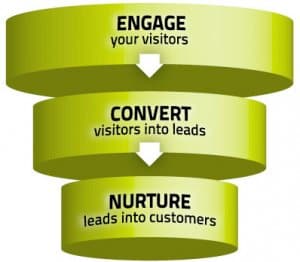Five Components in Every Effective Lead Nurturing Campaign
 There are certain necessary components to an effective lead nurturing campaign that every business should consider. Neglecting to first segment leads, rushing the relationship with obvious sales pitches, or offending customers by sending them irrelevant content will have a noticeably negative impact on results. Fortunately there are proven methods to improve the chances of converting a qualified lead into a sale.
There are certain necessary components to an effective lead nurturing campaign that every business should consider. Neglecting to first segment leads, rushing the relationship with obvious sales pitches, or offending customers by sending them irrelevant content will have a noticeably negative impact on results. Fortunately there are proven methods to improve the chances of converting a qualified lead into a sale.
Here are the top five components in every effective lead nurturing campaign.
Qualified and Segmented Leads
The first step in any lead nurturing campaign is to qualify and segment each lead. Lead nurturing is based on providing relevant content to each lead and it is too difficult to personalize the content for every individual lead. If each lead is divided into groups based on their demographics, online profile, and personal interests, campaigns can be created for each group instead of each person.
An Intent on Building a Lasting Relationship
Lead nurturing is not supposed to be used as a gimmick to quickly convert leads into sales. All lead nurturing efforts must be focused on building a long-term relationship based on trust. By establishing a business as an expert in their respective field, the potential consumer will be more likely to buy from them in the future, when they are ready. If the sales pitch is too strong or obvious, it could rush the decision and lose the customer in the process.
A Strategic Timeline
The frequency of lead nurturing attempts is also crucial to success. Most leads do not want to receive a new article or tutorial from the same business every day. Their inbox’s are already filled with messages from work, family, and friends. If lead nurturing is done too often, the lead could become annoyed and opt out of future messages. The same negative result can happen if the content is not sent often enough, since a lead will pay very little attention to a message they receive from some random company every few months. Depending on the business, 2-4 times per month seems to hold a lead’s interest without overwhelming them.
Interesting and Informative Content
The material that is being sent out to each lead needs to offer value to their lives or their business. It has to capture their attention and make them want to continue reading. Use the information gathered through the lead segmentation process to determine what the lead is interested in learning. Focus on general information that highlights the benefits of specific products or services without making it sound like a pushy sales ploy.
Method for Measuring Each Campaign`s Effectiveness
Every lead nurturing campaign will bring different results and it is essential that there is a way to analysis the results and their effectiveness. Certain content will draw a greater response and it is important to recognize which lead nurturing campaigns have the greatest conversion rate. Analyze results monthly to determine which nurturing campaigns are working and which need revision. Use a CRM to attribute revenue back to your nurture marketing campaign to measure ROI. Feed your prospects nurture campaigns that produce the highest ROI.
Lead nurturing has been proven time and time again to effectively convert leads into sales, but it has to be done right. Leads need to be qualified and segmented first and then a lasting relationship needs to be built using useful content over a strategic timeline, which will later be measured for effectiveness. Failure to consider any of these five components could negatively impact the effectiveness of a lead nurturing campaign.











